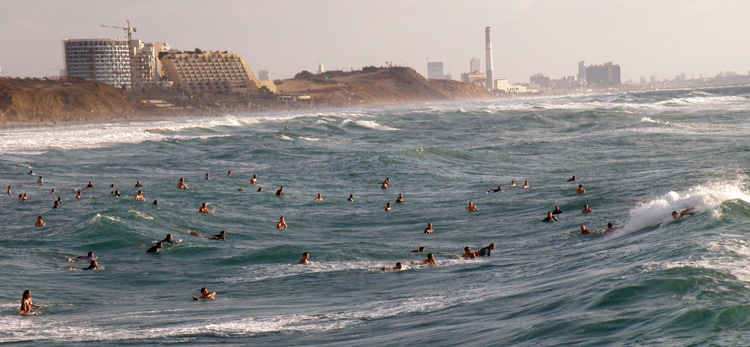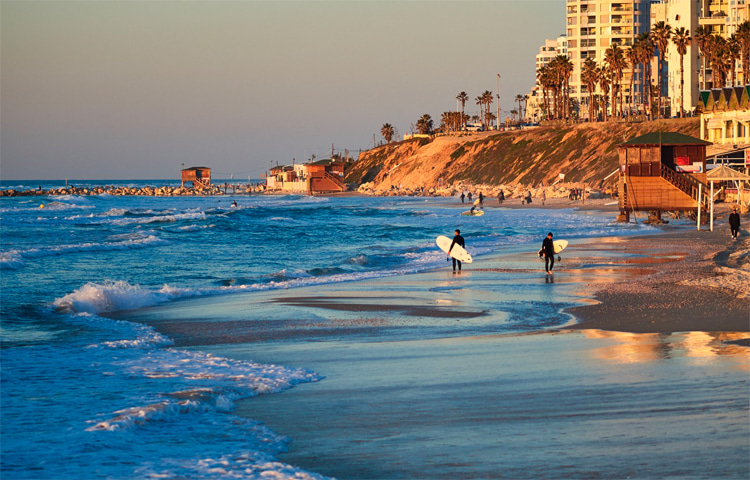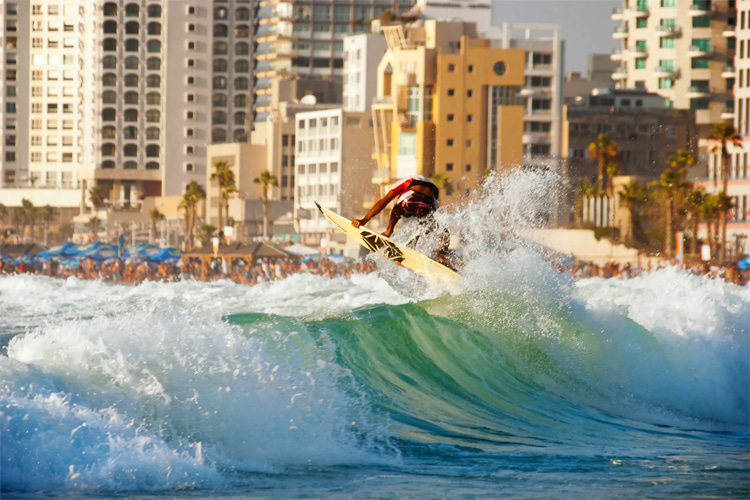The Mediterranea Sea is often a synonym for wind swells, small waves, and flat spells. However, there are occasional exceptions. Yes, Israel does get great surf.
Welcome to the Middle East, a geopolitical region of contrasts, beliefs, and cultures.
Israel is located on the southeastern end of the Mediterranean Sea. It is bordered by Egypt to the south and Lebanon to the north.
The nation, founded on May 14, 1948, features 170 miles (273 kilometers) of coastline.
The average temperatures range from 53 °F (12°C) in winter and 86 °F (30 °C) in summer. Nevertheless, it can snow in the capital city, Jerusalem.

The Dorian Paskowitz Legacy
The history of surfing in Israel dates back to 1956 when the Galveston-born Dorian "Doc" Paskowitz decided to volunteer for the Israeli army during the Suez crisis.
He was tired of his American life as a doctor and wanted to focus on his surfing. Paskowitz's plan didn't quite materialize, and he was rejected by the military.
However, he found splendid waves and left his 9'6" Hobie balsa surfboard to Israel's first surfers - Shaul Zinner and Shamai "Topsi" Kanzapolski.
After learning to surf at Hilton Beach, the duo started importing boards from California.
"By 1975, Hilton Beach had become the Malibu of Israel, and Kanzapolsky was making surfboards with locally produced materials," notes Matt Warshaw, author of "The Encyclopedia of Surfing."
Paskowitz considered "Topsi" to be the father of surfing in Israel.
Nir Almog, Kancepolsky's son, later went to America to learn how to shape surfboards and, in 1977, founded Israel's first surfboard company, Almog Surfboards.
The country held its first professional surfing contest in 1984 during the Association of Surfing Professionals (ASP) era.
The event had international stars, including Hans Hedemann, the Ho brothers, Wayne Bartholomew, Shaun Tomson, and Tony Moniz.
Three years later, the Israeli surf team finished third in the Eurosurf, surprising all other competitors.
How could a Mediterranean nation prevail in surfing? Well, it's simple - they can have great waves at home.
One of the Holy Land's surfing legends is Adi Gluska, a multiple-time national champion who started competing in the early 1990s.
The Israel Surfing Association was founded in 1986.

Surfing Jetty Land
Believe it or not, you can get consistent swells in Israel, as the country receives nearly all the wave energy generated in the Med.
During summer, NW wind swells will create ankle-to-waist-high waves; in the cold season, mid-period swells produced by SW winds will send up to six-foot surf to the Israeli coastline.
Actually, you can get barreled here.
The only problem is that you have to be quick to get to the beach, as these swells tend to die quickly.
The tidal range is also neglectable - only half a meter.
Tel Aviv is the surfing capital of Israel. The city is home to Hilton Beach, the country's most famous surf spot.
Two jetties shelter the surf break, and when the A-frame waves pop up, it can get crowded.
South of Tel Aviv, Maravi Beach is an open sand strip with big waves in winter and rideable waves during the warm season.
It is relatively consistent, offering both right and left-handers near the local stone poles.
In Netanya, Kontiki and Sironit are two well-known surf spots protected by breakwaters. Despite the shifting sands, they can deliver A-frame barrels with the right wind.
South of Caesarea, Arubot Beach is probably the best option, with its uncrowded waves breaking just in front of the local power plant turbines.
One of the Holy Land's best surfing waves can be found in Haifa.
Backdoor is a reef break protected by two jetties that produces a steep and hollow right-hand wave.
It works pretty well with Med's most powerful swells and offshore winds, especially in winter.
Not far, near Bat Galim Casino, you'll find several rideable peaks for longboarding and intermediate surfers. Mind the rocks, though.
In the region, also pay attention to The Peak, an interesting spot protected from SW wind by the Carmel Beach breakwall.
North of Haifa and almost near the Lebanese border, you'll reach Sokolov Beach, a fast and powerful high-performance wave capable of producing deep and heavy tubes.
It's one of the few Israeli surf spots working without jetties or breakwaters and the home of an annual surf contest.
